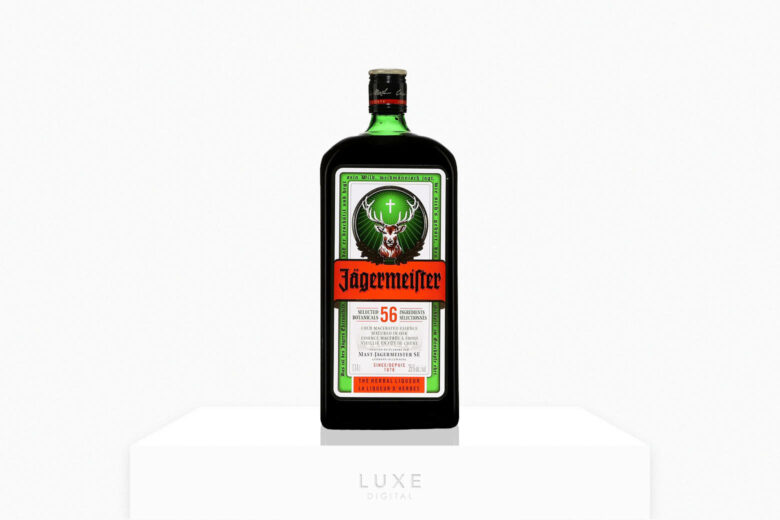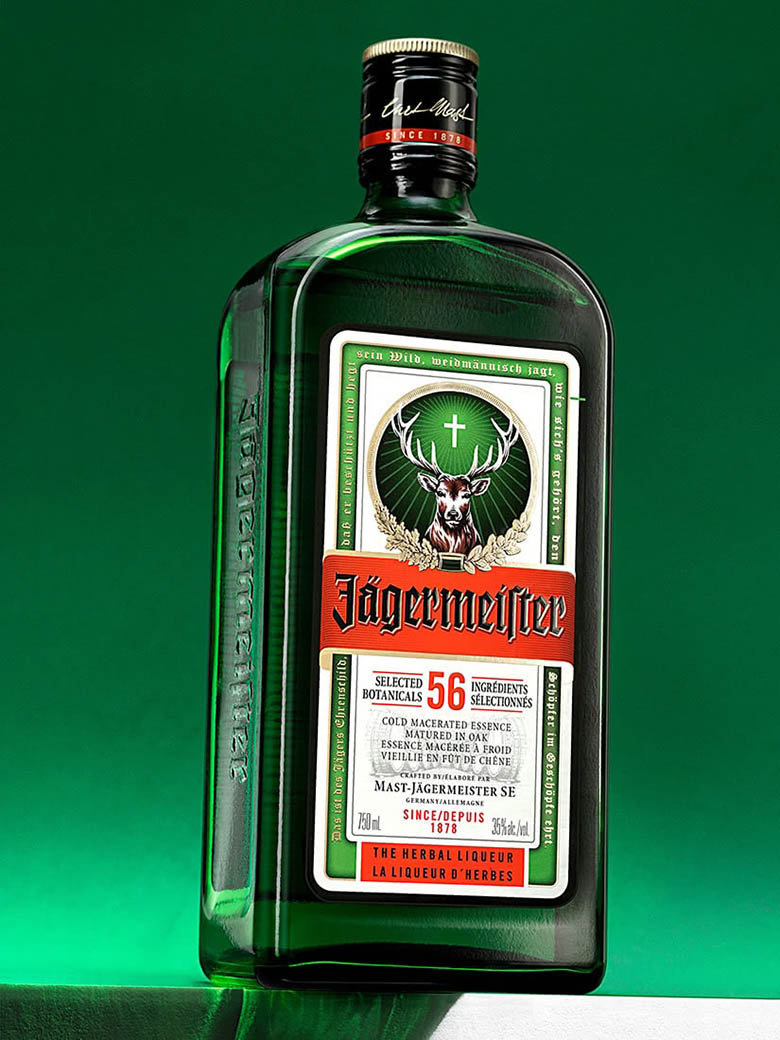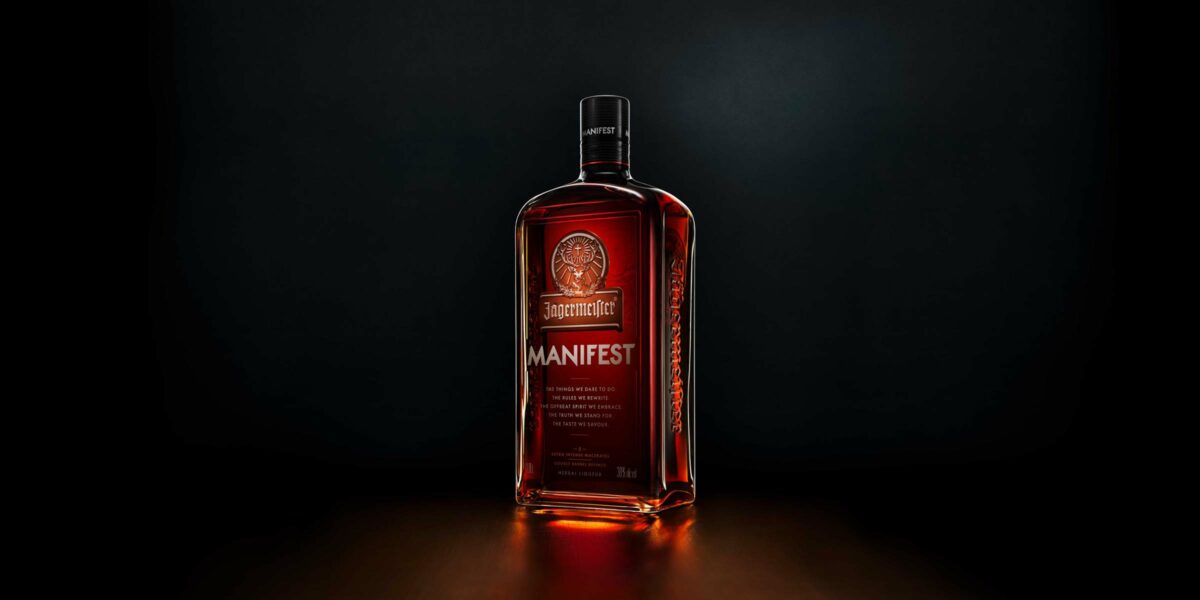Since its conception in 1934, Jägermeister has firmly earned its place as one of the most adored spirits in the world.
The instantly recognizable German herbal liqueur can be found on the shelf of any self-respecting bar and online alcohol store. In fact, despite only being launched in the UK in 2005, it’s fast become one of the nation’s favorite liqueurs. Not to mention the rest of the world.
Despite being traditionally enjoyed as a digestif (which is still the case in native Germany), it’s most well known for its common pairing with Red Bull: the Jagermeister bomb, also known as Jägerbomb.
Thought by its proponents as a somewhat uncouth method of consuming the complex blend, the Jägerbomb is a trend the brand has earnestly tried to move away from.
Purism aside; from the ostentatious bottle design to the German poetry adorning its label, Jägermeister certainly succeeds in being a unique liqueur brand.

Jägermeister price and bottle sizes
| Bottle | Size | Price (USD) |
|---|---|---|
| Jägermeister | 750ml | $17 |
| Jägermeister Manifest | 1 litre | $35 |
| Jägermeister Cold Brew Coffee Liqueur | 500ml | $26 |
Jägermeister: An origin story
The tale of Jägermeister comes infused with the quirks you might expect from a liqueur which began as vinegar, and whose name translates to ‘Master Hunter’.
In 1878, Wilhelm Mast of Lower Saxony, Germany, was happily running his vinegar-making business. The business bumbled along methodically until Wilhelm’s son, Curt, took over:
Armed with a penchant for spirit distillery and passion for experimentation, Curt halted the production of vinegar entirely. He wanted to exclusively focus on the manufacturing of alcohol spirits.
Talk about changing the direction of the business… Rather, Curt transformed it completely.
Still using the vinegar factory in his hometown of Wolfenbüttel, he eventually created a herbal infusion with a sharp injection of alcohol– and so Jägermeister was born.

If it’s not broken, don’t try and fix it
The recipe has remained the same for 75 years. Well, when you attain perfection, where do you go from there?
The Jägermeister ingredients list reads more like an apothecary’s tincture than popular alcohol, with extracts like ginseng, saffron, ginger, juniper berries, and of course, the principal flavor: licorice.
The raw ingredients are ground up, and steeped in water for several days. After a fastidious filtration process, the concoction is left to age in oak barrels for 365 days.
Finally, it’s blended with sugar, alcohol, and caramel to achieve its famously sweet flavor palate.
So, considering Jägermeister’s assiduous production process (not to mention the infusion of 56 herbs, fruits, roots, and spices) it does seem somewhat blasphemous to pollute it with a sugary energy drink.
It’s kind of like ordering a 50-year-old Balvenie scotch with coke. But hey, the people have spoken.

We need to talk about the deer blood:
There is a myth that somewhere in the production process, deer blood is added. This has since been debunked.
However, to strengthen the air of mystique, the precise ingredients remain a company secret (although they vehemently deny the presence of deer blood. Promise).

Finding the perfect bottle
Curt spent a lot of time and effort finding a sturdy bottle that would withstand being dropped. A logical decision, as his target market was somewhat heavy-handed, burly hunters.
While the hunters are long gone, Jägermeister has become a mainstay in rowdy nightclubs and riotous ski resorts where breakages are many. So, this was no doubt a wise move.
Curt’s research method was rather eccentric, but proved definitively effective:
He would drop a succession of green bottles from a height onto his oak kitchen floor to see which one would withstand the impact.
One after the other, bottles smashed to pieces in a total health and safety fiasco, until finally, one resilient bottle remained intact.
Curt had found his perfect bottle; it was this survivor that won the prestige of housing Jägermeister.
A victory indeed, although we don’t envy the cleanup.

Deciphering the Jägermeister label
The green and red label on every Jägermeister bottle is certainly eye-catching. The stag, the cross, the German poetry all contribute to its appeal. But what does it all mean?
The tale of Saint Hubertus
Hailing from Lower Saxony, where hunting stags was a popular and prestigious pastime, Curt Mast was an avid enthusiast of the hobby.
As such, Mast gained inspiration from the local folk tale of Saint Hubertus. Hubertus was once a careless, wild huntsman who took great pleasure in butchering every creature who crossed his path.
One day, he had a vision of a grand stag walking towards him with a luminous cross nestled within its antlers. The vision shook Hubertus irreparably, and he transformed into a conscientious being who possessed infinite respect for nature, and everything within it.
Although (somewhat surprisingly), he didn’t stop hunting stags. Well, you can’t have it all.
So, as a nod to local hunting culture and it’s champion Saint Hubertus, Mast decided the symbol would be perfect for his new liqueur.
And the poetry?
The poetry which borders each bottle roughly translates to:
“This is the hunters’ honors shield, which he protects and looks after his game, Huntsman hunts, as it should be, the Creator of the creatures honors”.
Um, we think you’ll agree that one kind of begs more questions than it answers.
Regardless, it clearly meant something to Mast, as it’s found on every single bottle of Jägermeister.
Wolfenbüttel
Like many unassuming small towns which happen to produce a talented distiller (we’re looking at you Lynchburg, TN), Wolfenbüttel has been placed firmly on the map thanks to its main export: Jägermeister.
The company’s HQ is still there today. However, the demand outgrew the old vinegar factory premises, and now three factories in the town produce Jägermeister.

How to drink Jägermeister?
We’re all familiar with how it’s normally consumed… But how is Jägermeister supposed to be enjoyed?
It’s best to store it in your freezer for an hour or so, so it can be served very cold (ideally at -18℃).
Then, in a chilled shot glass, pour yourself a generous splash. Sip slowly to enjoy the 56 unique flavors.
The best cocktails to make with Jägermeister
No, we’re not going to tell you how to make a Jägerbomb. For cocktails with a little more finesse, read on:
Jägermeister Deer and Beer

Ingredients:
- 40ml Jägermeister
- 330ml German beer
Cocktail recipes: Pour the chilled Jägermeister into an equally chilled shot glass. Then, pour the cold beer into a glass. Shot the Jägermeister, then drink the beer.
Jägermeister Mule

Ingredients:
- 50ml Jägermeister
- 120ml ginger beer
- Cucumber and lime wedge, to serve
Cocktail recipes: Squash the lime wedge at the bottom of a highball glass. Add ice cubes, then pour over the Jägermeister, then the ginger beer. Stir for a minute, then garnish with a slice of cucumber.
Jägermeister Old Fashioned

Ingredients:
- 15ml Jägermeister
- 45ml rye whiskey
- 15ml maple syrup
- Dash of Angostura bitters
- Orange zest, to serve
Cocktail recipes: Add ice to a rock’s glass. Pour over both Jägermeister and whiskey, then add maple syrup and bitters. Stir gently, then garnish with orange zest.
Frequently asked questions about Jägermeister
Although it varies, the typical cost of a Jägermeister shot is between $2.50 and $5.50. You can expect to pay marginally more for Jägermeister Manifest, the new, spicier version.
Jägermeister used to be very popular as a health tonic. Although its benefits are less than proven, there is anecdotal evidence to suggest it possesses anti-inflammatory properties and can ease symptoms of colds and flu. It’s also very good on a night out (although not so much for the next day).
Jägermeister is popularly enjoyed as a Jägermeister bomb, or ‘Jagerbomb’. This is where a shot of Jägermeister is dropped into a glass of Red Bull. However, you can also enjoy it as a digestif– just sip a neat shot slowly alongside food.
Jägermeister describes itself as ‘essentially a cocktail’. This is because it’s got a vast amount of botanical roots, spices, flowers, and herbs which combine to create a complex citrusy, licorice flavor.
Jägermeister is a type of liqueur named Kräuterlikör, which translates to ‘herbal liqueur’. It is made from macerated herbs.












